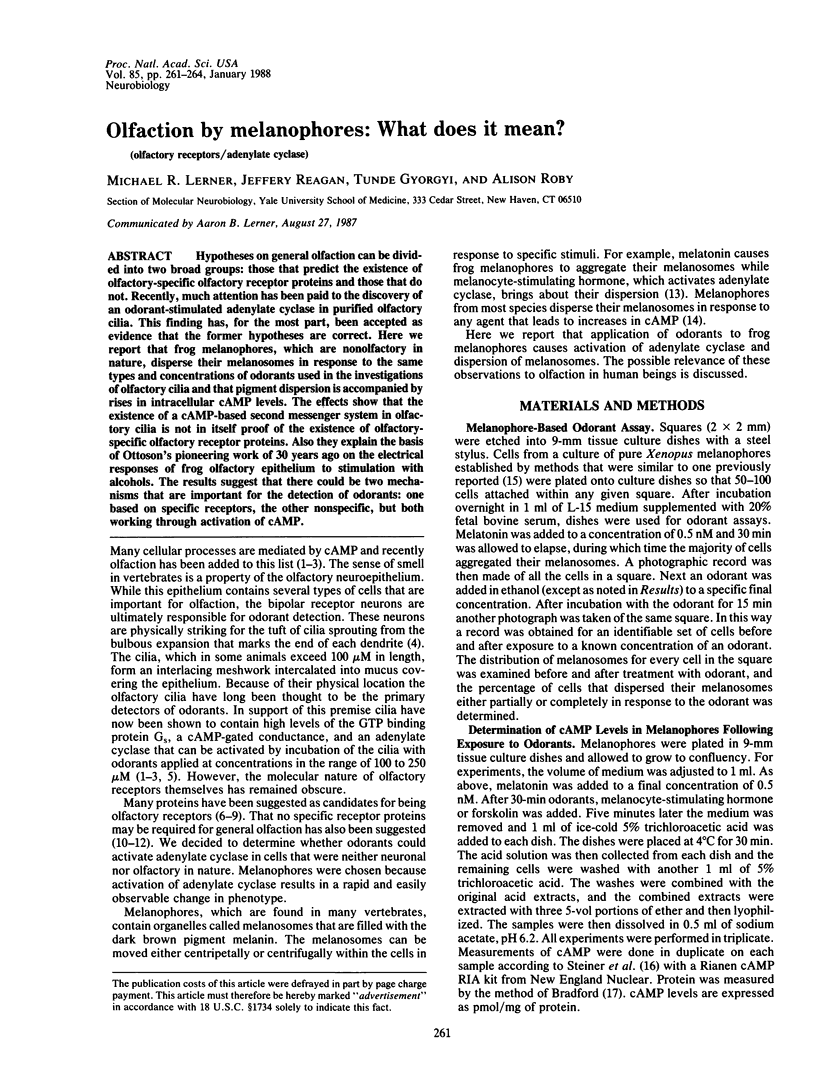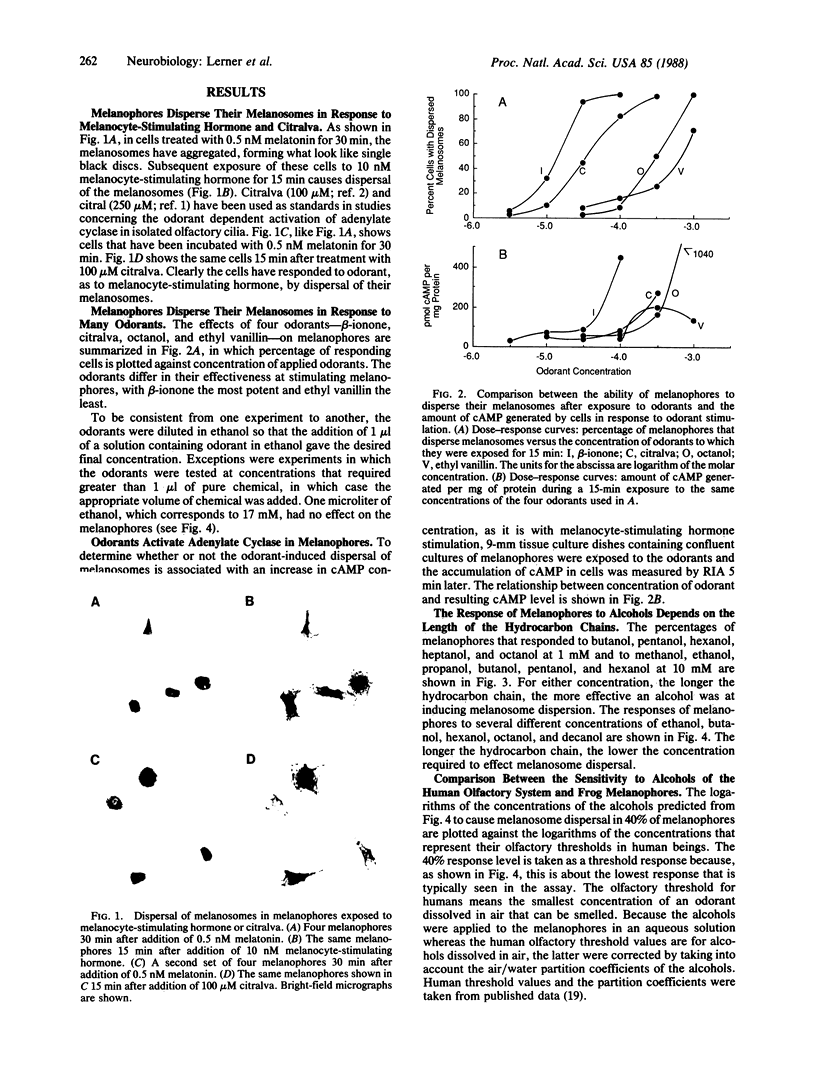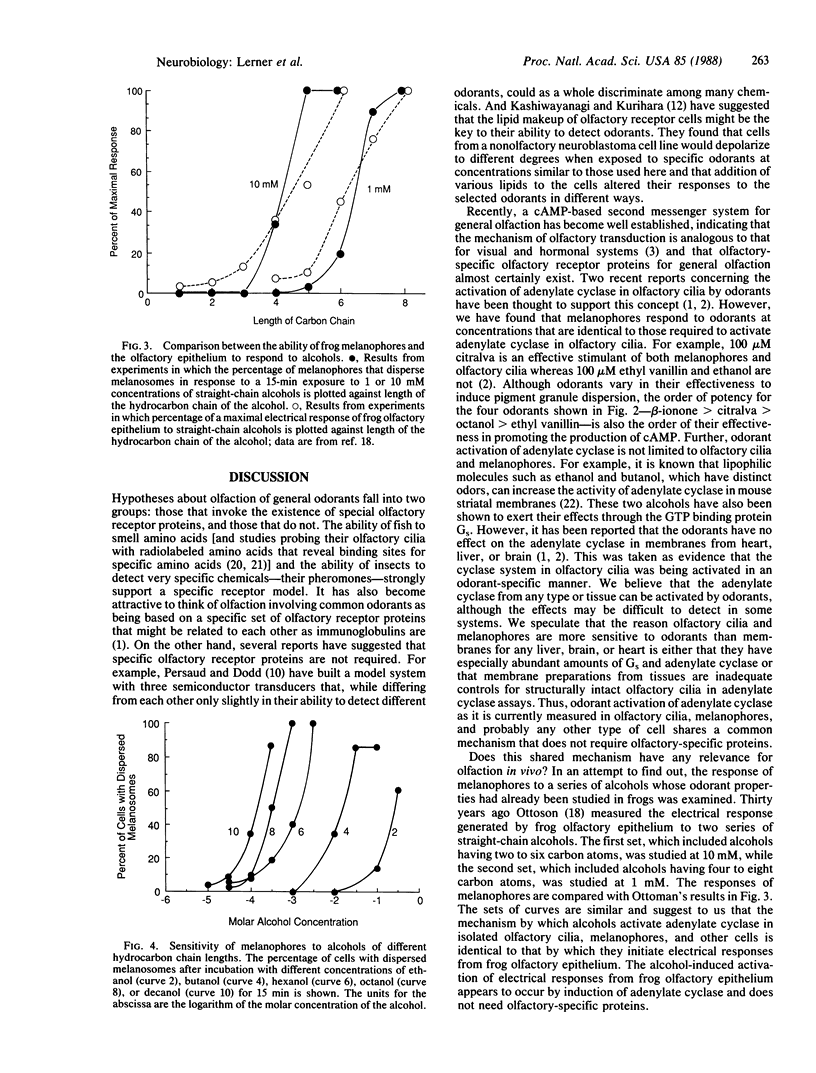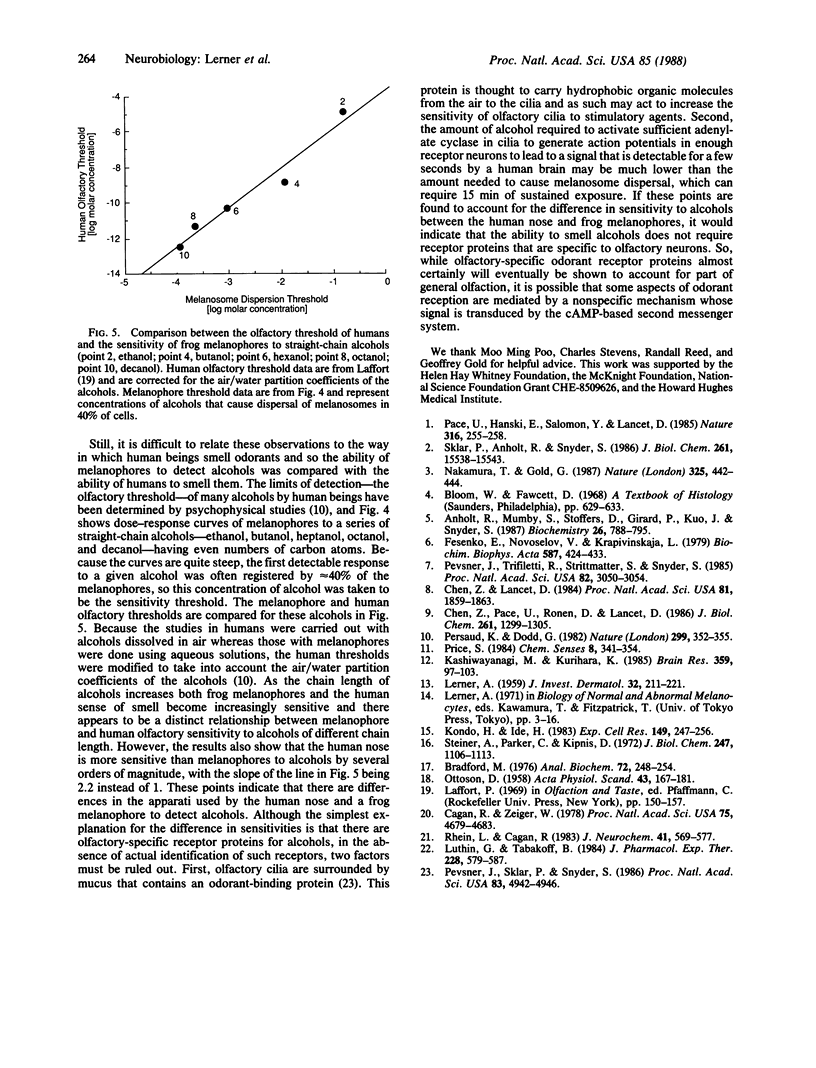Abstract
Hypotheses on general olfaction can be divided into two broad groups: those that predict the existence of olfactory-specific olfactory receptor proteins and those that do not. Recently, much attention has been paid to the discovery of an odorant-stimulated adenylate cyclase in purified olfactory cilia. This finding has, for the most part, been accepted as evidence that the former hypotheses are correct. Here we report that frog melanophores, which are nonolfactory in nature, disperse their melanosomes in response to the same types and concentrations of odorants used in the investigations of olfactory cilia and that pigment dispersion is accompanied by rises in intracellular cAMP levels. The effects show that the existence of a cAMP-based second messenger system in olfactory cilia is not in itself proof of the existence of olfactory-specific olfactory receptor proteins. Also they explain the basis of Ottoson's pioneering work of 30 years ago on the electrical responses of frog olfactory epithelium to stimulation with alcohols. The results suggest that there could be two mechanisms that are important for the detection of odorants: one based on specific receptors, the other nonspecific, but both working through activation of cAMP.
Full text
PDF



Images in this article
Selected References
These references are in PubMed. This may not be the complete list of references from this article.
- Anholt R. R., Mumby S. M., Stoffers D. A., Girard P. R., Kuo J. F., Snyder S. H. Transduction proteins of olfactory receptor cells: identification of guanine nucleotide binding proteins and protein kinase C. Biochemistry. 1987 Feb 10;26(3):788–795. doi: 10.1021/bi00377a020. [DOI] [PubMed] [Google Scholar]
- Bradford M. M. A rapid and sensitive method for the quantitation of microgram quantities of protein utilizing the principle of protein-dye binding. Anal Biochem. 1976 May 7;72:248–254. doi: 10.1006/abio.1976.9999. [DOI] [PubMed] [Google Scholar]
- Cagan R. H., Zeiger W. N. Biochemical studies of olfaction: binding specificity of radioactively labeled stimuli to an isolated olfactory preparation from rainbow trout (Salmo gairdneri). Proc Natl Acad Sci U S A. 1978 Oct;75(10):4679–4683. doi: 10.1073/pnas.75.10.4679. [DOI] [PMC free article] [PubMed] [Google Scholar]
- Chen Z., Lancet D. Membrane proteins unique to vertebrate olfactory cilia: candidates for sensory receptor molecules. Proc Natl Acad Sci U S A. 1984 Mar;81(6):1859–1863. doi: 10.1073/pnas.81.6.1859. [DOI] [PMC free article] [PubMed] [Google Scholar]
- Chen Z., Pace U., Ronen D., Lancet D. Polypeptide gp95. A unique glycoprotein of olfactory cilia with transmembrane receptor properties. J Biol Chem. 1986 Jan 25;261(3):1299–1305. [PubMed] [Google Scholar]
- Fesenko E. E., Novoselov V. I., Krapivinskaya L. D. Molecular mechanisms of olfactory reception. IV. Some biochemical characteristics of the camphor receptor from rat olfactory epithelium. Biochim Biophys Acta. 1979 Oct 18;587(3):424–432. doi: 10.1016/0304-4165(79)90446-x. [DOI] [PubMed] [Google Scholar]
- Kashiwayanagi M., Kurihara K. Evidence for non-receptor odor discrimination using neuroblastoma cells as a model for olfactory cells. Brain Res. 1985 Dec 16;359(1-2):97–103. doi: 10.1016/0006-8993(85)91416-7. [DOI] [PubMed] [Google Scholar]
- Kondo H., Ide H. Long-term cultivation of amphibian melanophores. In vitro ageing and spontaneous transformation to a continuous cell line. Exp Cell Res. 1983 Nov;149(1):247–256. doi: 10.1016/0014-4827(83)90396-8. [DOI] [PubMed] [Google Scholar]
- LERNER A. B., CASE J. D. Pigment cell regulatory factors. J Invest Dermatol. 1959 Feb;32(2 Pt 2):211–221. [PubMed] [Google Scholar]
- Luthin G. R., Tabakoff B. Activation of adenylate cyclase by alcohols requires the nucleotide-binding protein. J Pharmacol Exp Ther. 1984 Mar;228(3):579–587. [PubMed] [Google Scholar]
- Nakamura T., Gold G. H. A cyclic nucleotide-gated conductance in olfactory receptor cilia. 1987 Jan 29-Feb 4Nature. 325(6103):442–444. doi: 10.1038/325442a0. [DOI] [PubMed] [Google Scholar]
- OTTOSON D. Studies on the relationship between olfactory stimulating effectiveness and physico-chemical properties of odorous compounds. Acta Physiol Scand. 1958 Aug 25;43(2):167–181. doi: 10.1111/j.1748-1716.1958.tb01585.x. [DOI] [PubMed] [Google Scholar]
- Pace U., Hanski E., Salomon Y., Lancet D. Odorant-sensitive adenylate cyclase may mediate olfactory reception. Nature. 1985 Jul 18;316(6025):255–258. doi: 10.1038/316255a0. [DOI] [PubMed] [Google Scholar]
- Persaud K., Dodd G. Analysis of discrimination mechanisms in the mammalian olfactory system using a model nose. Nature. 1982 Sep 23;299(5881):352–355. doi: 10.1038/299352a0. [DOI] [PubMed] [Google Scholar]
- Pevsner J., Sklar P. B., Snyder S. H. Odorant-binding protein: localization to nasal glands and secretions. Proc Natl Acad Sci U S A. 1986 Jul;83(13):4942–4946. doi: 10.1073/pnas.83.13.4942. [DOI] [PMC free article] [PubMed] [Google Scholar]
- Pevsner J., Trifiletti R. R., Strittmatter S. M., Snyder S. H. Isolation and characterization of an olfactory receptor protein for odorant pyrazines. Proc Natl Acad Sci U S A. 1985 May;82(9):3050–3054. doi: 10.1073/pnas.82.9.3050. [DOI] [PMC free article] [PubMed] [Google Scholar]
- Rhein L. D., Cagan R. H. Biochemical studies of olfaction: binding specificity of odorants to a cilia preparation from rainbow trout olfactory rosettes. J Neurochem. 1983 Aug;41(2):569–577. doi: 10.1111/j.1471-4159.1983.tb04777.x. [DOI] [PubMed] [Google Scholar]
- Sklar P. B., Anholt R. R., Snyder S. H. The odorant-sensitive adenylate cyclase of olfactory receptor cells. Differential stimulation by distinct classes of odorants. J Biol Chem. 1986 Nov 25;261(33):15538–15543. [PubMed] [Google Scholar]
- Steiner A. L., Parker C. W., Kipnis D. M. Radioimmunoassay for cyclic nucleotides. I. Preparation of antibodies and iodinated cyclic nucleotides. J Biol Chem. 1972 Feb 25;247(4):1106–1113. [PubMed] [Google Scholar]



